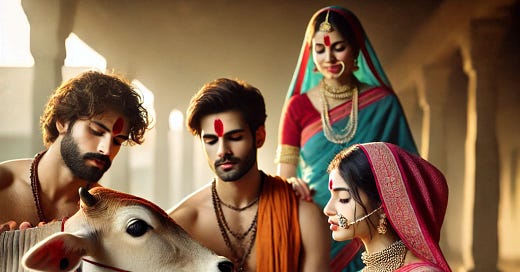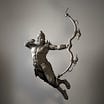In Hindu culture, traditionalist conservatism is more than an ideological stance; it is a profound commitment to values rooted in the ancient Vaidika tradition — a heritage that has been nurtured, preserved, and evolved over thousands of years. This form of conservatism entails a conscious choice to align with principles that transcend fleeting societal trends, embracing timeless wisdom over the impermanence of contemporary priorities. At the heart of Hindu conservatism are two guiding pillars: orthodoxy (right belief) and orthopraxy (right practice). Orthodoxy encompasses the core beliefs that shape Hindu thought, while orthopraxy brings those beliefs to life through action, cultivating a lifestyle deeply integrated with spiritual values.
Equally vital to this worldview is social conservatism, which emphasizes preserving societal norms, moral values, and family structures that are seen as essential to maintaining a cohesive and stable community. Social conservatism aims to protect institutions such as marriage, family, and community life from the often-disruptive forces of rapid modernization, prioritizing collective well-being and balanced order. Together, these principles work to nurture environments where individuals and communities can flourish, guided by a foundation of enduring, supportive traditions.
Orthodoxy: The Foundation of Traditionalist Conservatism
In traditionalist conservatism, orthodoxy forms the bedrock of belief, preserving core doctrines that define the Hindu worldview. Drawn from Vaidika literature, these teachings offer both metaphysical insights and practical guidance on how to live a balanced, righteous life. Among the essential beliefs are:
Reverence for Śāstra: Traditionalist conservatism holds Vaidika scriptures — the Vedas, Upaniṣads, Smṛtis, Itihāsas, and Purāṇas — as sacred, authoritative sources of timeless wisdom. These texts are not relics; they are living guides that provide insight and clarity in navigating life’s complexities, relevant across generations.
Belief in Karma, Rebirth, and Mokṣa: The traditionalist perspective embraces karma, the law of cause and effect, viewing life as a series of interconnected actions that shape future outcomes. This cycle continues through rebirth until one achieves mokṣa, or liberation, which gives life a deeper spiritual direction and purpose.
Faith in the Guru: The Guru, or spiritual teacher, is central to traditionalist Hinduism. Acting as a bridge between ancient wisdom and the modern seeker, the Guru provides guidance aligned with Śāstra, keeping the disciple’s spiritual journey on a meaningful and purposeful path.
Orthopraxy: Lived Expressions of Faith
For traditionalist conservatism, orthopraxy — or the practice of beliefs — is essential. Hinduism emphasizes that thought and action must be inseparable, with faith manifesting through concrete, daily practices that reinforce devotion and spiritual discipline.
Following Svadharma: Svadharma, or one’s personal duty, is defined by one’s varṇa (societal role) and āśrama (stage of life). Traditionalist conservatism encourages individuals to embrace roles that align with their nature and responsibilities, supporting social harmony over individual ambition.
Daily Worship and Rituals: Rituals such as daily pūjā (worship), yajña (fire sacrifices), and fasting form an integral part of Hindu orthopraxy. Celebrating festivals like Diwali, Holi, and Navaratri is more than tradition; it renews one’s connection to divine forces and the natural world.
Nitya Upāsanā (Daily Worship): Practices like mantra chanting, japa (repetition of God’s name), and meditation nurture a disciplined mind and deepen the devotee’s relationship with the divine.
Observing Kula Āchāra (Family Traditions): Adhering to family customs honors lineage and ensures the continuity of ancestral wisdom, weaving a connection to one’s roots across generations.
Following the Guru’s Guidance: The Guru’s teachings extend beyond the spiritual, often including practical advice on living in harmony with dharma. By following the Guru’s guidance, individuals contribute to ṛta (cosmic order), aligning their lives with a larger, harmonious whole.
Social Conservatism: Upholding Community and Moral Order
Social conservatism in the Hindu tradition places great emphasis on maintaining societal values and structures essential to a stable community. It promotes cultural norms, family integrity, and communal bonds, viewing the well-being of the collective as fundamental to personal welfare.
Family as Society’s Core: In traditionalist conservatism, the family is sacred, the first sphere where values and traditions are imparted. It provides children with a sense of respect, loyalty, and dharma, and serves as a foundation for Hindu customs and practices.
Supporting Marriage and Community Institutions: Social conservatism considers marriage a binding union that sustains family structure and societal stability. Community institutions reinforce cultural practices and foster relationships, creating a connected, interdependent society.
Balancing Individual and Collective Needs: While acknowledging individual aspirations, social conservatism asserts that personal goals should harmonize with societal balance. By valuing dharma (righteous conduct) and ṛta (cosmic order), social conservatism nurtures an environment where personal fulfilment contributes positively to the whole.
Orthopraxy and Social Conservatism: Why They Matter Today
In Hinduism, orthopraxy complements orthodoxy, ensuring that beliefs are not abstract but actively expressed through daily practices. Social conservatism further grounds these practices within a framework that values collective welfare and stability. This combination of orthodoxy, orthopraxy, and social conservatism fosters virtues like discipline, humility, and devotion, contributing to personal growth and social harmony. In an era marked by materialism and individualism, traditional customs and communal values offer stability, continuity, and a sense of belonging.
Addressing the “Hindu Taliban” Mischaracterization
Critics on social media who liken Hindu conservatives to the “Taliban” fundamentally misunderstand Hindu conservatism and, in doing so, distort its nature. Hindu traditionalism is not an authoritarian movement but rather a framework deeply rooted in the belief that adherence to dharma and to one’s svadharma (personal duty) is essential for a stable and moral society. Unlike ideologies that impose beliefs through coercion or suppression, Hindu conservatism respects the sacred order, or ṛta, as a guiding force. This respect for divine law inspires a voluntary, conscientious adherence to time-honoured practices — practices designed to cultivate discipline, moral integrity, and a life lived in harmony with cosmic principles.
Hindu traditionalism stands as a bulwark against a rapidly individualizing society and the erosion of social structures under the guise of liberal progress. Those who wish to impose purely modern, secular values upon Hindu society fail to see that such a shift risks unravelling the very framework that has sustained Hindu culture for millennia. Hindu conservatism is not arbitrary or oppressive but is based on profound insights passed down through the śāstra. These insights maintain that moral order is upheld through well-defined roles, communal responsibility, and an adherence to dharma — all of which are essential in preventing societal degeneration.
Modern liberalism, which often champions individualism above collective responsibility, undermines these structures by prioritizing personal autonomy over family, community, and social cohesion. In doing so, it risks dismantling the familial and communal bonds that Hindu conservatism holds sacred. When social roles and responsibilities are disregarded, the result is often a fracturing of social integrity, increased moral relativism, and the weakening of institutions that form society’s backbone. Hindu conservatism argues that imposing liberalism’s “anything goes” ethos onto Hindu society is a dangerous path, one that can lead to a breakdown of moral and social order, or adharma.
Hindu traditionalism, therefore, is not an inflexible dogma but a worldview rooted in reverence for an ordered society. It asserts that freedom must be balanced with responsibility, individual rights with communal duties. By centring life around dharma and the wisdom enshrined in the śāstra, Hindu conservatism seeks to cultivate a society that resists moral degradation and remains aligned with a higher, sacred purpose.
Tradition as a Pillar of Cultural Identity
For a traditionalist conservative, preserving cultural identity is more than preserving the past; it is about rooting oneself in something enduring. Culture, with its art, literature, music, language, and daily practices, represents the accumulated wisdom of generations. In a globalized world, where cultural distinctions can be diluted, upholding tradition becomes an act of resilience and connection to one’s heritage. Traditionalist conservatism sees this preservation not as nostalgia but as a vital commitment to the enrichment of individual and communal life.
Community and Social Cohesion
The concept of sangha (association or community) holds central significance in Hindu traditionalism, representing a microcosm of the cosmic order. Life is understood in relation to family, community, and society, governed by a web of duties and responsibilities articulated through varṇa-āśrama dharma. This structure fosters a balanced society where each individual, by fulfilling their role, contributes to the welfare of the whole, cultivating virtues like compassion, loyalty, and sacrifice.
Tradition and Adaptation
Traditionalist conservatism values continuity but recognizes the need for adaptation when circumstances require it. Adaptation is pursued not for novelty but to preserve core values in changing contexts. This approach allows traditionalism to remain a living, evolving path rather than a rigid adherence to outdated forms, enabling it to offer relevant guidance across generations.
The Importance of Virtues in a Modern World
Discipline, humility, and devotion are core virtues in traditionalist conservatism, cultivated through ethical conduct, religious practices, and fulfilling one’s duties. These virtues align individuals with ṛta, the cosmic order central to Hindu thought. In a rapidly changing world, these virtues provide stability, grounding individuals in integrity and a sense of connection to a larger, enduring order.
Conclusion: Revitalizing Tradition in a Modern Age
To be a traditionalist conservative is to live a life that respects the wisdom of the past while thoughtfully engaging with the demands of the present. Through a commitment to orthodoxy, orthopraxy, and social conservatism, traditionalism fosters a balanced approach that roots individuals in an enduring order, offering guidance and resilience in a rapidly changing world.







This is an excellent article, I am going to share this to my friends, family.
The authoritative scriptures of Sanatana Dharma are the Upanishads, the Bhagavad Gita, and the Brahma Sutra, collectively known as the Prasthanathrayam. However, the Puranas and Smritis are not considered authoritative by the great Hindu seers (acharyas) due to their conflicting accounts of creation and the promotion of caste discrimination. For instance, the Shiva Puranas present Shiva as the creator, while the Vishnu Puranas attribute creation to Vishnu, and the Devi Puranas elevate the Mother as the supreme deity. These texts also attempt to reconcile these gods as a single entity, yet the contradictions persist. Furthermore, some interpolated Smritis and Dharma Shastras enforce harsh penalties for violating caste rules.
In truth, Varna is not determined by birth but rather by an individual’s qualities and actions. Varna is meant to be fluid and adaptable, yet it has been distorted into a rigid, birth-based hierarchy that enforces a social order of superiority and inferiority among Hindus. This misinterpretation has damaged Hindu unity and often positions Hindus as adversaries within their own tradition. Despite this, orthodox factions resist reform.
Moreover, Hinduism is often viewed as a distorted representation of Sanatana Dharma. According to Sanatana Dharma, creation unfolds through Manus, after whom cycles of creation, known as Manvantaras, are named. Here, it is Manu—rather than Brahma or other mythological gods—who is recognized as the creator. While Hinduism incorporates the worship of a diverse pantheon (the Trimurti and other deities), Sanatana Dharma emphasizes monotheism, with Brahman, the Supreme Light, as the singular focus of worship.
In Sanatana Dharma, liberation (mukti) is achieved only after transcending various celestial realms (or lokas), such as Rishi Loka, Janar Loka, Mahar Loka, Brahm Loka, and ultimately Parabrahm Loka—higher spiritual planes beyond the heaven (swarga) of the devatas. Conversely, Hinduism’s devotional practices are often confined to the devatas or deities, leaving the souls of ancestors (pitrus) ineligible for liberation. These souls remain in a cycle of rebirth as they do not reach Brahman’s realm.
For an in-depth exploration, you may refer to the e-book, "The Battle for Bharat," available on Amazon: [The Battle for Bharat](https://amzn.in/d/ipUNdrM).